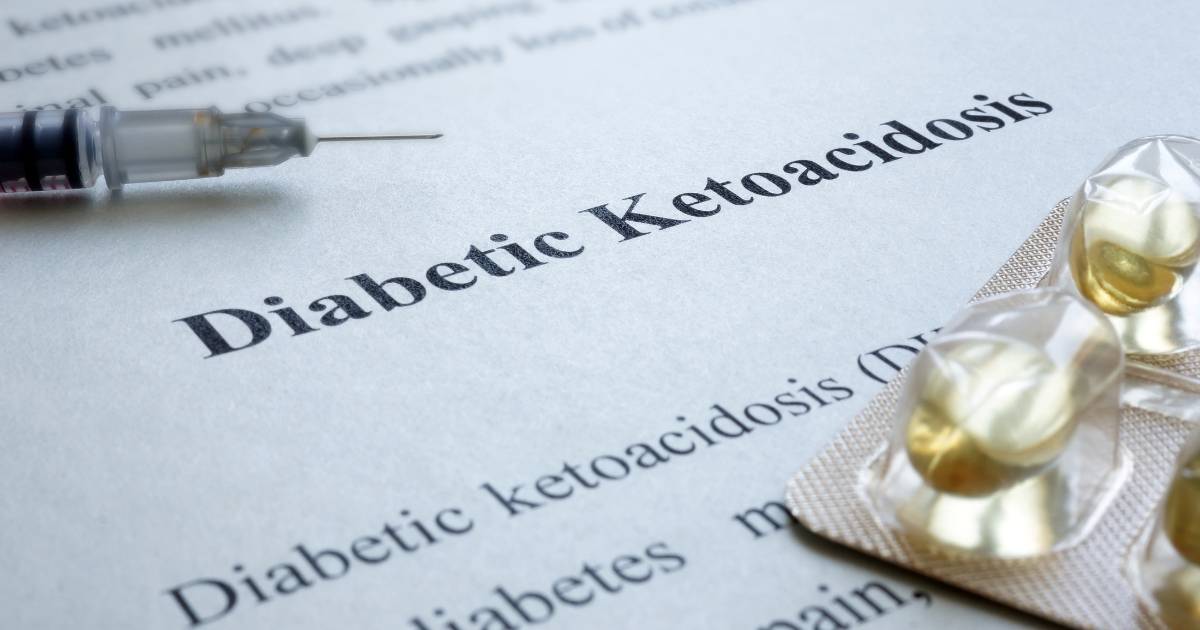[ad_1]
If blood sugar levels become too high, they can develop into a dangerous condition known as diabetic ketoacidosis (DKA.)
DKA can be fatal if not treated quickly by medical professionals. But what exactly is DKA, and how can you prevent it?
This article will explain everything you need to know about diabetic ketoacidosis or DKA.

Why do people with diabetes get high blood sugar?
People with diabetes either do not make enough insulin, or their bodies do not make any insulin at all.
Without insulin, glucose overflows in the blood, resulting in high blood sugar.
When someone has diabetes, they try to prevent high blood sugar levels with diet and exercise, or prescribed medications, such as metformin or insulin.
How quickly can high blood sugar become dangerous?
High blood sugar levels can become dangerous quickly, even over several hours or days.
This may happen if you’ve run out of insulin, are rationing your insulin, forgot to take your insulin, or if you’re suffering from an illness or infection.
High blood sugars of over 250 mg/dL with ketones may indicate diabetic ketoacidosis (DKA), which is extremely dangerous and will require immediate medical attention.
Contact your doctor right away if your blood sugar levels are high and you’re consistently testing positive for ketones.
Read more: What Levels of Blood Sugar Are Dangerous?
What is diabetic ketoacidosis?
Diabetic ketoacidosis, or DKA, is a serious short-term complication of diabetes that develops when the blood turns acidic from too many ketones in the body, from extremely high blood sugar levels.
DKA will usually set in after blood sugar levels have surpassed 250 mg/dL for several hours or days, along with the presence of ketones in the blood and urine.
It develops when the body cannot metabolize any glucose ingested because there is no insulin available in the body. This results in rapid deterioration and requires immediate emergency medical attention.
Ketoacidosis can happen quickly from a complete lack of insulin. This can be due to an insulin pump failure or forgetting to take an injection before a meal.
DKA can also develop more slowly, due to regular sickness and high blood sugars over the course of several days.
Ketoacidosis occurs in people with type 1 diabetes more often than in people living with type 2 diabetes. About 25% of patients are in DKA at diagnosis with type 1 diabetes.
Although rare, some people who don’t have diabetes can get ketoacidosis too. It can be caused by chronic alcoholism, starvation, or an overactive thyroid.
What are the symptoms of DKA?
If you live with diabetes (especially type 1 diabetes), always be aware of the symptoms of DKA.
These symptoms include:
Is DKA life-threatening?
Yes. If left untreated, DKA can lead to diabetic coma and death.
Call 911 or go to your local emergency department if you think you are in DKA and/or have a blood sugar of 250 mg/dL or higher.
You should seek medical attention if you are experiencing moderate to high ketones for several hours and cannot get your blood sugar down.
Everyone with diabetes should have at-home ketone strips to test for ketones and to help prevent the onset of DKA.
How do you treat DKA?
DKA should always be treated in a hospital setting by medical professionals.
The usual course of treatment involves an increased insulin dosage by IV, administration of fluids for rehydration, and electrolyte balancing with sodium and potassium.
Many patients will spend several days in the hospital until blood sugar levels are safely back in a normal range, the patient is re-hydrated, and all electrolytes are in balance again.
How can I prevent DKA?
The best way to prevent DKA is to keep your blood sugar levels within a healthy range. Check your blood sugar levels more often when you are sick or fighting off an infection.
Always take all your medications as prescribed, and never ration or use expired medications, especially insulin.
It is also important to stay hydrated and exercise regularly.
Seek emergency medical care quickly if you’re experiencing high blood sugar of over 250 mg/dL for several hours or days along with ketones.
Prevention of DKA at the diagnosis of type 1 diabetes is harder because it often resembles other illnesses such as the flu or the norovirus.
Call your doctor if you’re experiencing symptoms of high blood sugar and suspect you may have diabetes. Getting a swift diagnosis is key to preventing DKA.
What is the most common complication of DKA?
Surprisingly, the most common complication of DKA is low blood sugar.
Many people will take too much insulin trying to bring their blood sugars down, resulting in them crashing too quickly and experiencing hypoglycemia.
Low blood sugar occurs in 5-25% of all patients with DKA.
It is important that medical professionals bring blood sugars down slowly to not shock the body and to prevent low blood sugar.
Other complications of DKA include:
- muscle weakness
- cardiac arrest
- coma
- cerebral edema
- acute kidney failure
- acute respiratory failure
- death.
Are there long-term consequences of DKA?
If treated quickly, many people survive DKA with no long-term health consequences.
However, many cases of DKA are not treated quickly enough (mostly because the symptoms often look like the flu or other viruses.)
DKA may cause permanent kidney damage, brain damage, cardiac arrest, coma, or death.
It is crucial to have DKA treated promptly by medical professionals to prevent long-term health consequences.
What is the survival rate of DKA?
The mortality rate of DKA is just under 5% for people under 40 years old.
The mortality rate is over 20% for older individuals.
Death usually occurs due to low potassium levels, induced arrhythmias, and brain swelling—which is more common in children.
[ad_2]
Source_link

